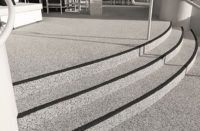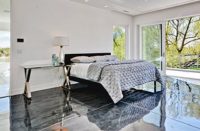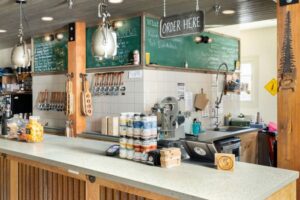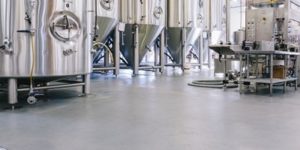
All decorative concrete work needs to be protected.
“But protected from what?” asks Shawn Wardall of Specialized Construction Services Inc. in Waterloo, Wisconsin.
It’s a crucial question regarding coatings for horizontal concrete installations and restorations — whether the coating is serving a protective-only mission or protective-decorative function.
“Penetrating sealers leave a very nice natural look and offer a certain level of protection, but a coating will almost always offer a greater level of protection,” Wardall says. “But is it chemical resistant enough? How much will it amber (take on a yellowish tint)? What level of maintenance is required to maintain the desired look?”
Matt Blackburn, a regional sales manager for coatings manufacturer Key Resin Co., says the key to specifying or choosing a coating typically boils down to three variables: budget, time and quality.
Expanding on these fundamentals, Westcoat Specialty Coating Systems’ Todd Cook says the factors to be considered in specifying coatings for decorative concrete begin with the space and environment.
“Substrate conditions, expected use of the space, and how the inhabitants will interact with the environment all play an important role when it comes to specifying these finishes,” says Cook, Westcoat technical sales representative.
Our experts
Concrete Decor contacted the following coatings experts, formulators and suppliers to help shed some light on the coating choices available today for interior and exterior floors and other horizontal concrete surfaces:
Specific issues to take into account include the type of traffic (vehicular, foot, forklift, other), the expected UV exposure, VOC or LEED considerations, skid resistance, potential chemical or water exposure, local building and health codes, and waterproofing requirements, just to name a few.
“Let’s say an architect is trying to specify stained concrete for an office TI (tenant improvement) project. One of the first considerations should be the substrate. Is the existing substrate suitable to stain and seal or to stain and polish?” Cook asks.

Existing floor finishes, such as carpet or tile, may result in potential imperfections in the slab and may yield an appealing rustic look. Then again, these imperfections may not fit with the overall design, and a cementitious overlay may provide a more uniform canvas before stains and sealers or topcoats can be applied, he says.
As for anticipated use of the space, Cook cites a brewery as a good example. “Brewery floors are exposed to a lot of harsh conditions that can result in a coating failure if the proper solution isn’t specified,” he says. Epoxies have long been a standard material for such facilities, but urethane cements have emerged as a formidable alternative due to a combination of resistance to moisture, thermal shock, heat and impact.
Needless to say, aesthetics also figures prominently in coating selections. A desired palette may limit the type of material that can be used. Acid stains, for example, are a proven and durable solution for staining concrete but come in limited colors. Sheen may also be limited by the medium or material used.
“This is where it’s crucial that architects and specifiers make use of the manufacturer’s architectural representatives,” Cook says, and get an on-site mock-up to illustrate the actual finished result.
Here’s a rundown of the various coatings on the market today:
The coatings mix
Coatings specifiers and users can choose from a varied mix of products for concrete floors and other horizontal concrete surfaces, from clear sealers that protect the decorative surface while essentially going unnoticed, to colorful, glossy and special-effect finishes that enhance powerful design statements while boosting durability.
Acrylics. Acrylic sealers are a widely used and economical option for horizontal concrete, and are available in a range of solids-content levels and in water- and solvent-borne versions. These materials work well as a low-cost, utilitarian coating choice, but frequent recoating is often needed.
Fast-drying acrylic lacquer-type sealers are billed as easy to apply, single-component products that can be used directly on concrete. Attributes include high gloss and a degree of UV and stain resistance, and a finish that can be easily recoated and maintained.
Solvent-borne acrylics can be used on interior and exterior settings, and are a common choice for residential interiors, patios and pool decks. Performance limitations outside can include premature loss of gloss and occasional whitening from water.
Water-borne, low-VOC acrylic sealers are used where environmental impact is a major concern, but are rarely considered for commercial projects. They don’t adhere to concrete as well as solvent-borne sealers and they don’t enhance color.
Some acrylic sealers are modified with slow-evaporating solvents to improve application and performance. Others have silane added to boost water and efflorescence resistance.
Epoxies. A major player in the concrete floor coatings arena, epoxies come in water-borne, solvent-borne and 100-percent solids forms, and are typically multicomponent systems — bisphenol A resins combined when applied with polyamide or polyamine curing agents. These high-performance coatings deliver good abrasion resistance and a high degree of chemical resistance.
Polyamide epoxy coatings, used more frequently on concrete floors, are more flexible and water resistant, while amine-cured epoxies are superior in chemical resistance.
Water-borne epoxies, a performance upgrade from acrylics, are very user friendly. They are typically used on the interior, but on the exterior can be used as a primer under a urethane topcoat. These epoxies are more durable and chemical resistant than acrylics, but many are susceptible over time to amber with UV exposure.

For decorative concrete, two-component water-borne epoxies are popular for interior sealer/topcoat applications because they’re versatile and perform well. They also can be used as primers. These user-friendly coatings have a long pot life and dry rapidly. They’re available in varying gloss levels in clear or pigmented formulations.
Also in the epoxy category, high-build, 100-percent solids are the basis for decorative quartz and color-chip systems, and as clear epoxy finishes for various decorative concrete interior floors. Key properties include 100-percent solids formulation, superior clarity and high build. A polyurethane topcoat can boost their scrub, stain and scratch resistance.
Epoxy novolac products are characteristically similar to 100-percent solids epoxies, but they’re more heat and chemical resistant — a key attribute in areas such as commercial kitchens, warehouses and manufacturing plants where there are high temperatures or exposure to chemicals and cleaners.
These high-build coatings, typically applied at 20 mils or greater, come clear or pigmented. They cure very quickly and may require specialized application equipment. Extensive surface preparation, such as roughening the surface, is usually required.
Polyurethanes. Polyurethanes for concrete are multicomponent, high-performance materials formed by the reaction of a polyisocyanate and hydroxyl-containing resin blend. Available as solvent and water-borne coatings, they are highly abrasion and chemical resistant. Polyurethanes are widely used premium coatings, and carry a price tag that reflects this reputation.
Polyurethanes are usually applied to a roughened concrete surface with conventional sprayers in one or two coats at a few mils per coat and cure within several hours. They also are used as topcoats over epoxy coatings in projects exposed to sunlight and other weather.
Single-component, moisture-cured polyurethanes are designed to react with moisture to produce a tough, durable film. These one-component resins can be an advantage when handling and applying because less equipment is needed.
Polyurethanes that deliver higher film builds come in high-solids or 100-percent solids formulas and are used in demanding settings where chemical resistance is a must. As with high-build epoxies, you must abrade or roughen the surface before applying these coatings, usually with specialized equipment.
Today’s manufacturers have developed extremely versatile interior and exterior polyurethane products that can be applied directly to concrete or used as a topcoat over epoxies or as a protective finish for microtoppings and overlays. Available as clear or pigmented VOC-compliant coatings, these polyurethanes are highly resistant to UV rays and abrasion.
Solvent-borne, two-component polyurethanes deliver long-term durability with their UV, chemical and stain resistance. They are well suited for commercial or industrial settings with extensive foot and vehicular traffic. However, these products are highly flammable and have a strong odor, which make them problematic for restaurants, retail spaces and institutional facilities that must remain open during maintenance and renovation.

Water-based polyurethanes, which come in a variety of gloss levels for interior and exterior applications, perform comparably to solvent-borne products but are low odor and nonflammable. These benefits make water-bornes a popular choice where other trades or tenants are present, or in settings where minimal odor is a must.
As with solvent-bornes, application versatility is part of the package, as they can be used over epoxies and cementitious treatments, as well as applied directly to concrete. Rapid dry time is another plus.
Polyaspartics. Based on a reaction of an aliphatic polyisocyanate and a polyaspartic ester, high-performance polyaspartic coatings boast a similar profile to polyurethanes in terms of the cured film’s durability and toughness, but they cure more rapidly. These high-build materials can be used like epoxies.
Polyaspartics are marketed as a one-coating product that provides the performance of a two-coat system.
Polyureas. Polyureas are mainly used as heavy-duty protective coating systems for demanding applications such as those associated with transportation, pipeline, tank linings, marine, wastewater treatment, truck bed linings and parking decks. Architectural and decorative uses are limited, partly because of their extremely rapid cure time.
Polyureas, however, can be modified for decorative applications by blending them with other resins such as polyaspartics to slow down their ultra-fast cure time.
These two-component, fast-cure modified polyureas are UV, chemical and abrasion resistant; high-build; durable; and available clear and pigmented. They offer a quick-dry and low-odor alternative to epoxies or as a topcoat/sealer for epoxy systems.
Modified polyureas are suitable for interior and exterior uses. These low-viscosity materials produce a high-gloss finish, and are offered in formulations tailored for use as topcoats in protective-coatings and seamless-flooring installations.
These coatings can be used as finish coats in color-chip and color-quartz decorative flooring and other architectural concrete applications. Although characterized by rapid cure, some polyureas are formulated to cure slowly enough to allow effective brush and roller application. Also offered are primer/topcoat products used in decorative color-chip systems that can be applied in one day.

Polished concrete sealers
Sealers, or “guards,” for polished concrete add protection against stains and chemicals that could adversely affect the ground, densified and polished surface. Application of a guard is particularly important in polished concrete colored with stains or dyes.
Guards can be reapplied or reburnished in areas of heavy traffic without having to strip the sealer. They also can enhance the polished surface’s shine.
Many manufacturers of coatings and polished concrete systems offer sealer/guard products. Formulas include acrylics, proprietary acrylic copolymers modified with silicate hardeners (densifiers), polyurethanes, water- and solvent-based methacrylates, acrylic/wax and polyurethane/wax combinations, other proprietary polymer blends and the relatively recent arrival — UV-cured clear sealers.
Also used on polished concrete are various penetrating repellents — nonfilm-forming materials such as those based on silanes. These “penetrants” repel water and other liquid substances but are “breathable” in that they don’t trap moisture in the substrate and allow water vapor to escape.
www.covestro.com
www.element7concrete.com
www.prosoco.com
www.specializedinc.net
www.westcoat.com
















